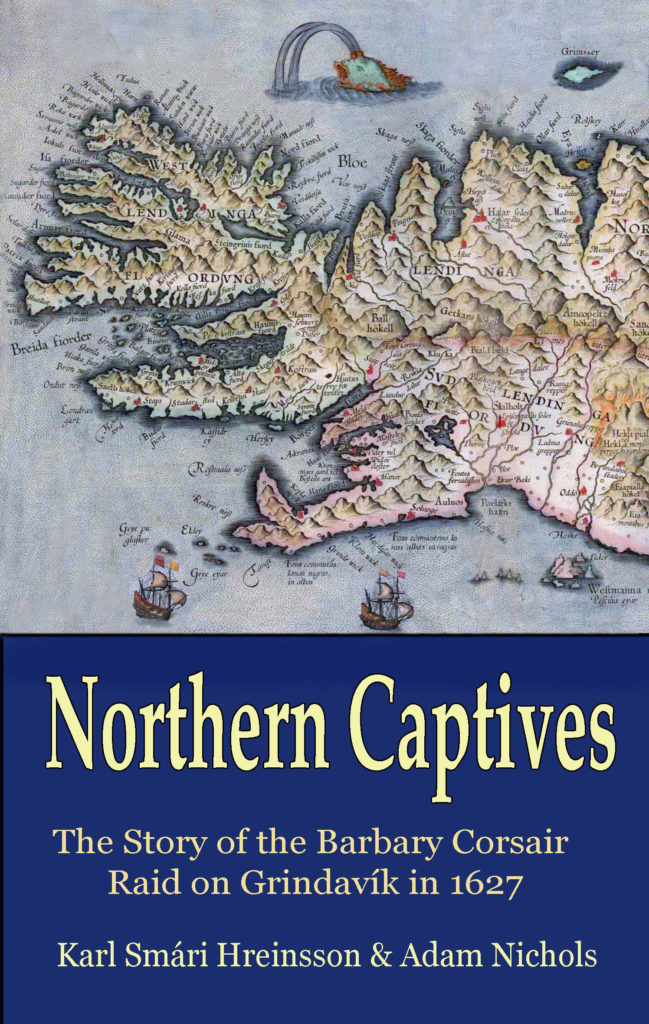Back in 2016, my Icelandic colleague, Karl Smári Hreinsson, and I published The Travels of Reverend Ólafur Egilsson: The Story of the Barbary Corsair raid on Iceland in 1627 with the Catholic University of America Press. There’s a link to that book here in this blog.
Over the past couple of years, Karl and I completed two more books devoted to the Barbary corsair raids on Iceland in 1627.
One, titled Northern Captives, tells the story of the raid by corsairs from Salé on southwest Iceland. It details the events of the attack itself and then follows the Icelandic captives to Salé, where they were sold into slavery.
The second book, titled Stolen Lives, tells the story of the raid by corsairs from Algiers on southeastern Iceland and the Westman Islands. It details the events of the two attacks and then follows the Icelandic captives to Algiers, where they too were sold into slavery.
Below are the front-cover images accompanied by the back-cover blurbs for the books.
In the summer of 1627, Barbary corsairs raided Iceland. They killed dozens of people and captured over four hundred, packing the captives aboard their ships and transporting them to North Africa to be sold in the slave markets there. The first place the corsairs attacked in Iceland was Grindavík. This book recounts the story of that attack and its aftermath—a story that has never before been told.
The very last thing the inhabitants of Grindavík expected, living as they were on an island close to the Arctic Circle in the middle of the turbulent North Atlantic, was to be attacked by Barbary corsairs from North Africa.
So when a lone ship silently approached the harbor early on a June morning in 1627, nobody on shore took alarm. Barbary corsairs had a reputation for brutal violence, but they also used stealth when it suited their purposes. By the time the people of Grindavík realized what was happening, it proved too late, and the corsairs, howling like a pack of wolves, were upon them.
This book recounts the events of the raid on Grindavík, as well as what happened afterward, when those captured were taken to Salé, a notorious corsair capital on the Atlantic coast of Morocco, and sold into slavery there. In particular, it follows the fortunes and misfortunes of one of the prominent farm families of the time, two generations of which were captured in the raid.
The full story of the Grindavík raid has never before been told. This book recounts for the first time the details of what happened and the terrors and triumphs of the Icelanders caught up in the raid.
In the summer of 1627, two groups of Barbary corsairs raided Iceland, one from Salé, on the Moroccan coast, and one from Algiers. Between them, they killed dozens of people and captured over four hundred, packing the captives aboard their ships and transporting them to North Africa to be sold in the slave markets there. Most of these captives were taken from Heimaey, one of the Westman Islands. This book recounts the story of the corsair raid on Heimaey and its aftermath, a story that has never before been told in full.
The corsairs landed over 200 men on Heimaey and in two days of violent raiding captured nearly 250 people, including many women and children. Adding these new captives to the more than 100 they had already taken in East Iceland, they then set sail for Algiers, their home port.
In Algiers, many of the captive Icelanders quickly succumbed to disease and shock. Those who survived were auctioned off into slavery and forced to endure hard servitude until a ransom expedition was finally organized to liberate them, almost a decade after their initial capture. In the end, only twenty-seven made it back to Iceland.
The full story of the Algerine corsair raid on Heimaey has never been told. Drawing on a wide variety of contemporary sources, this book recounts for the first time not only the details of the raid itself, but also the experience of being a slave in Algiers, the process by which the enslaved Icelanders were ransomed, and the journey home for the lucky ones.
Stolen Lives is a story of brutality and suffering, but also of the resiliency of the human spirit in the face of bitter adversity.
These books were published in Iceland (Northern Captives in 2020, Stolen Lives in 2021) and are for sale throughout the island. So any of you who may be contemplating a visit to Iceland will be able to buy copies at any decent Icelandic bookshop.
For those of you who may not be contemplating a trip to Iceland, these books are also available online from an Icelandic vendor called Sigvaldi.
Below are individual links to Northern Captives and Stolen Lives at the Sigvaldi website:
Northern Captives and Stolen Lives are narrative histories. That is, they tell the story—present a narrative—of what happened in novelistic fashion. We focus on the characters of the story as much as possible, and we try to evoke for the reader what the early seventeenth century world was like, how it felt to be the victim of a corsair attack and to be sold in a North African slave market, and what it was like to live in a place like Salé or Algiers in the late 1620s.
I’m going to devote the next few weeks of this blog to excepts from Northern Captives and Stolen Lives .
This week’s excerpt (see the next post here in this bog) is from Northern Captives.
It is about Murad Reis, the leader of the corsair expedition from Salé.

Corsairs and Captives
Narratives from the Age of the Barbary Pirates
View Amazon listing
The Travels of Reverend Ólafur Egilsson
The story of the Barbary corsair raid on Iceland in 1627
View Amazon listing
